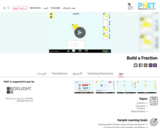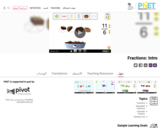
Special Delivery Task Template and Student Version of Task
- Subject:
- Mathematics
- Material Type:
- Lesson Plan
- Provider:
- VDOE
- Author:
- VDOE
- Date Added:
- 10/04/2024

Special Delivery Task Template and Student Version of Task

Understanding how and why equivalent fractions are needed - Algebra Readiness Remediation Plan

Build fractions from shapes and numbers to earn stars in this fractions game or explore in the Fractions Lab. Challenge yourself on any level you like. Try to collect lots of stars!

This video is part of the Continue to Know with WHRO TV series. Watch Kyle Snyder teach how to compare fractions.

HyperDocs are GoogleDocs that allow students to interact with teacher-curated content to explore a subject. This HyperDoc, created by Fern Vogt, focuses on equivalent fractions. There are Khan Academy videos and plenty of opportunities for students to practice.

Match shapes and numbers to earn stars in this fractions game. Challenge yourself on any level you like. Try to collect lots of stars! The main topics of this interactive simulation include fractions, equivalent fractions, and mixed numbers.

Explore fractions while you help yourself to 1/3 of a chocolate cake and wash it down with 1/2 a glass of orange juice! Create your own fractions using fun interactive objects. Match shapes and numbers to earn stars in the fractions games. Challenge yourself on any level you like. Try to collect lots of stars!

In Unit 6, students extend and deepen Grade 1 work with understanding halves and fourths/quarters (1.G.3) as well as Grade 2 practice with equal shares of halves, thirds, and fourths (2.G.3) to understanding fractions as equal partitions of a whole. Their knowledge becomes more formal as they work with area models and the number line. Throughout the module, students have multiple experiences working with the Grade 3 specified fractional units of halves, thirds, fourths, sixths, and eighths. To build flexible thinking about fractions, students are exposed to additional fractional units such as fifths, ninths, and tenths.
This unit affords ample opportunity for students to engage with the Standards for Mathematical Practice. Students will develop an extensive toolbox of ways to model fractions, including area models, tape diagrams, and number lines (MP.5), choosing one model over another to represent a problem based on its inherent advantages and disadvantages. Students construct viable arguments and critique the reasoning of others as they explain why fractions are equivalent and justify their conclusions of a comparison with a visual fraction model (MP.3). They attend to precision as they come to more deeply understand what is meant by equal parts, and being sure to specify the whole when discussing equivalence and comparison (MP.6). Lastly, in the context of line plots, “measuring and recording data require attention to precision (MP.6)” (MD Progression, p. 3).
Unfortunately, “the topic of fractions is where students often give up trying to understand mathematics and instead resort to rules” (Van de Walle, p. 203). Thus, this unit places a strong emphasis on developing conceptual understanding of fractions, using the number line to represent fractions and to aid in students' understanding of fractions as numbers. With this strong foundation, students will operate on fractions in Grades 4 and 5 (4.NF.3—4, 5.NF.1—7) and apply this understanding in a variety of contexts, such as proportional reasoning in middle school and interpreting functions in high school, among many others.

In this unit, students develop general methods and strategies to recognize and generate equivalent fractions as well as to compare and order fractions.
Thus, students begin this unit where they left off in Grade 3, extending their understanding of and strategies to recognize and generate equivalent fractions. Students use area models, tape diagrams, and number lines to understand and justify why two fractions a/b and (n×a)/(n×b) are equivalent, and they use those representations as well as multiplication and division to recognize and generate equivalent fractions. Next, they compare fractions with different numerators and different denominators. They may do this by finding common numerators or common denominators. They may also compare fractions using benchmarks, such as “see[ing] that 7/8<13/12 because 7/8 is less than 1 (and is therefore to the left of 1) but 13/12 is greater than 1 (and is therefore to the right of 1)” (Progressions for the Common Core State Standards in Math, pp. 6–7).
Students engage with the practice standards in a variety of ways in this unit. For example, students construct viable arguments and critique the reasoning of others (MP.3) when they explain why a fraction a/b is equivalent to a fraction (n×a)/(n×b). Students use appropriate tools strategically (MP.5) when they choose from various models to solve problems. Lastly, students look for and make use of structure (MP.7) when considering how the number and sizes of parts of two equivalent fractions may differ even though the two fractions themselves are the same size.

Build equivalent fractions with different denominators. Match shapes and numbers to earn stars in the game. Challenge yourself on any level you like. Try to collect lots of stars!

Just in Time Quick Check Equivalent Fractions

This video is part of the Continue to Know with WHRO TV series. Watch Kyle Snyder teach how to order fractions from least to greatest.